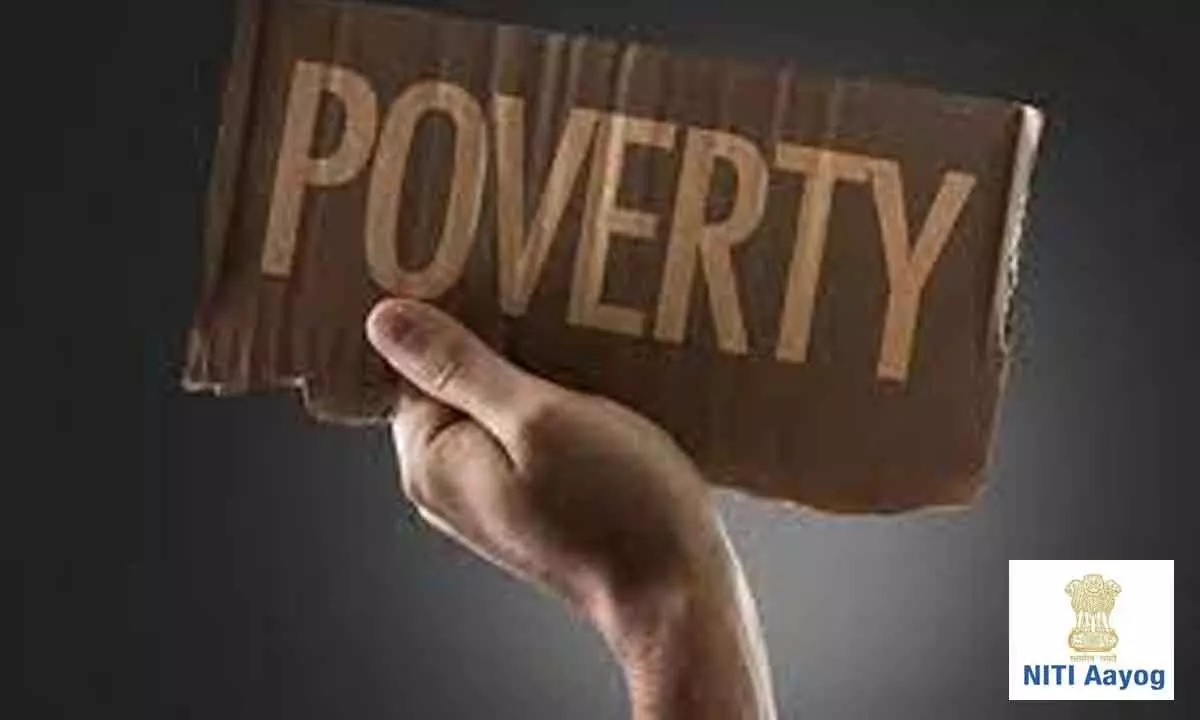Live
- Wanaparthy collector reviews on survey of welfare schemes
- NDRF, NDA always come to rescue in case of disasters
- ‘Bhairavam’ teaser is just around the corner
- ‘Shiva Sambho’ blends culture and devotion in Telugu cinema
- Akash Jagannadh extends generous support to veteran Actress Pavala Syamala
- 'Attack' on Kejriwal: Atishi claims BJP wants to harm ex-CM, Parvesh hits back
- Amit Shah emphasizes Centre's commitment to AP development
- Bangladeshi angle in Saif Ali Khan stabbing case raises political din
- CII pegs India's growth rate at 7 per cent for 2025-26 amid rising private investments
- Smith injures elbow ahead of for SL tour, Kuhnemann nursing thumb surgery
Just In
India Witnesses Remarkable Progress As 24.82 Crore People Escape Multidimensional Poverty


- A recent NITI Aayog report unveils a substantial reduction in multidimensional poverty across India, with millions lifting themselves out of poverty between 2013-14 and 2022-23.
- The report highlights significant improvements in health, education, and living standards, emphasizing the collective efforts of states like Uttar Pradesh, Bihar, and Madhya Pradesh.
The NITI Aayog report highlights a significant and commendable reduction in multidimensional poverty across India. According to the report, a staggering 24.82 crore people successfully lifted themselves out of multidimensional poverty between the years 2013-14 and 2022-23. This positive trend is indicative of substantial progress in addressing various facets of poverty and improving the overall well-being of a considerable portion of the population.
Uttar Pradesh, Bihar, and Madhya Pradesh emerged as the frontrunners in this transformative journey, with a large number of individuals escaping poverty in these states. The collective effort contributed to a nationwide decline in multidimensional poverty from 29.17% in 2013-14 to 11.28% in 2022-23, marking a noteworthy reduction of 17.89 percentage points during this period.
The report underscores the multidimensional poverty index (MPI), which evaluates deprivations across health, education, and standard of living through 12 sustainable development goals-aligned indicators. These indicators include nutrition, child and adolescent mortality, maternal health, years of schooling, school attendance, cooking fuel, sanitation, drinking water, electricity, housing, assets, and bank accounts. The comprehensive approach provides a holistic understanding of poverty, going beyond just income measures.
At the state level, Uttar Pradesh leads the list with 5.94 crore people escaping poverty, followed by Bihar at 3.77 crore and Madhya Pradesh at 2.30 crore. All 12 indicators of the MPI have shown remarkable improvement, reflecting positive strides in various dimensions of well-being.
Prime Minister Narendra Modi acknowledged the encouraging findings in a tweet, expressing that the progress reflects the government's commitment to fostering inclusive growth and implementing transformative changes in the economy. The government aims to bring multidimensional poverty below 1%, and the report suggests that India is well on its way to achieving this ambitious goal.
The report also anticipates that India is poised to reach single-digit poverty levels by 2024. It notes a faster decline in the poverty headcount ratio between 2015-16 and 2019-21 compared to the period from 2005-06 to 2015-16. This acceleration in poverty reduction is attributed to the concerted efforts and initiatives implemented during these years.
Furthermore, the report indicates reduced disparities among poorer states, with the pace of decline in poverty being faster in these regions. This positive trend aligns with the country's commitment to achieving Sustainable Development Goals (SDGs), specifically SDG 1.2, which aims to reduce multidimensional poverty by at least half before 2030.
Despite these positive strides, the report also highlights persistent challenges, such as high deprivation in cooking fuel and housing. Efforts to address these challenges, coupled with ongoing initiatives like Poshan Abhiyan and Anemia Mukt Bharat, aim to further enhance access to healthcare facilities and decrease deprivation.
In conclusion, the NITI Aayog report signifies a substantial leap forward in India's battle against multidimensional poverty, showcasing a comprehensive and holistic approach towards improving the lives of millions.

© 2025 Hyderabad Media House Limited/The Hans India. All rights reserved. Powered by hocalwire.com






